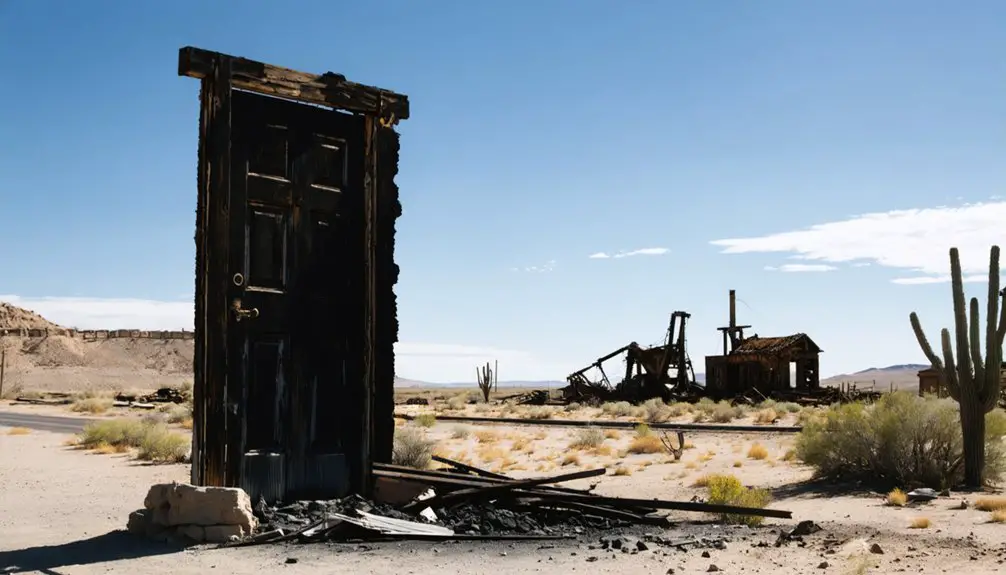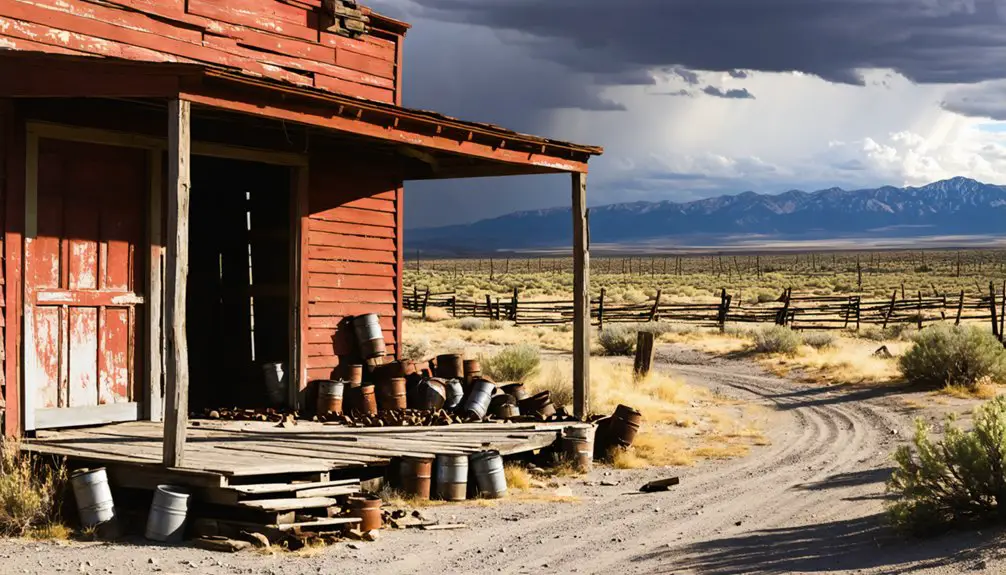You’ll find Osceola Ghost Town 50 miles southeast of Ely, Nevada, where gold discoveries in 1872 sparked a mining boom that attracted 1,500 residents. The town flourished through innovative hydraulic mining operations, yielding $5 million in precious metals by 1900. While devastating fires ultimately led to its decline, you can still explore the brick storefront ruins, historic graveyard, and remnants of extensive water systems that once powered this frontier settlement’s ambitious mining operations.
Key Takeaways
- Osceola Ghost Town lies 50 miles southeast of Ely, Nevada, featuring brick storefronts, ruins, and a historic graveyard from its mining era.
- The town boomed from 1877-1900, reaching 1,500 residents and producing $5 million in gold through innovative hydraulic mining operations.
- Devastating fires throughout the 1880s-1940s destroyed most structures except the stone Marriott General Store, leading to population decline.
- Ancient Fremont Indian artwork in nearby caves and remnants of extensive water management systems showcase the area’s historical significance.
- Located near Great Basin National Park, visitors must bring water and respect private property while exploring this testament to Nevada’s mining heritage.
The Birth of a Mining Frontier (1872)
While prospectors had long suspected gold deposits in eastern Nevada, it wasn’t until 1872 that James Matteson and Frank Heck made their pivotal discovery near what would become Osceola.
You’ll find their gold discovery sparked an initial rush of activity across a substantial quartz belt stretching 12 miles long and 7 miles wide. Within six years, prospectors had staked roughly 100 claims in the quartz veins, though early lode mining proved unprofitable.
The sprawling quartz belt drew hopeful miners by the hundreds, yet their eager claims yielded little profit from the stubborn veins.
The real breakthrough came in 1877 when John Versan discovered placer gold in a ravine between Wet Gulch and Dry Gulch. This find revolutionized the area’s mining techniques, as prospectors shifted from difficult lode extraction to more profitable placer mining operations. The town’s population swelled to around 1,500 residents during its peak years.
The change marked the beginning of Osceola’s transformation from a mere prospect to a thriving mining frontier. This transformation led to the discovery of a massive $6,000 gold nugget that helped sustain mining operations well into the next century.
Gold Rush Prosperity and Town Development
After Osceola’s initial gold discoveries ignited interest in the region, the town experienced remarkable growth and development between 1877 and 1900. You’d have witnessed the transformation as the population swelled to 1,500 residents, with gold mining operations yielding an impressive $5 million in precious metals. The expansive gold quartz belt stretched an impressive 12 miles long by 7 miles wide.
Despite economic challenges and water scarcity, you would’ve seen innovative solutions emerge. The town pioneered Nevada’s first hydraulic mining operations, supported by an extensive network of ditches and pipelines stretching up to 18 miles. The Osceola Placer Mining Company completed this vital ditch system in 1884, revolutionizing local mining methods.
Three stamp mills processed ore while modern amenities like electricity and telephone service set Osceola apart from other mining camps. The town’s strategic location near Spring and Snake Valleys’ ranches guaranteed a steady supply of goods, though periodic fires threatened its prosperity, particularly the devastating 1890 blaze that marked the beginning of its gradual decline.
Water Systems and Hydraulic Mining Operations
You’ll find Osceola’s innovative water system relied on two major mountain stream diversions – the 16-mile West Ditch and 18-mile East Ditch – which delivered essential water to the mining operations.
The East Ditch, completed in 1890 at a cost of $20,000, featured 2.2 miles of wooden flumes and a 633-foot tunnel that channeled water from Lehman Creek and its tributaries.
The extensive pipeline infrastructure represented cutting-edge hydraulic mining technology for Nevada, though water shortages would ultimately limit the district’s long-term success. In total, the hydraulic mining operations extracted approximately five million in gold before operations ceased in 1900.
Mountain Stream Diversion Networks
Three major water diversion networks transformed Osceola’s mining operations during the 1850s, with the Rock Creek Ditch serving as the most significant engineering feat.
You’ll find this nine-mile system, completed in 1850 at a cost of $10,000, carved through challenging mountain terrain to supply the Coyote Diggings camp.
The networks relied heavily on natural snowmelt, channeling millions of gallons daily through an intricate system of flumes and canals.
While these engineering marvels enabled profitable mining operations, they dramatically altered stream ecology and water quality in the surrounding mountains.
Today, you can still trace remnants of these extensive water management systems, which included stormwater diversions and sophisticated monitoring stations.
The infrastructure’s impact permanently changed local watersheds, leaving lasting evidence of humanity’s determined pursuit of mineral wealth.
Mining Pipeline Infrastructure Development
Building upon the established water diversion networks, Osceola’s mining operations underwent a dramatic transformation with the implementation of hydraulic mining technology in the 1880s.
You’ll find remarkable pipeline engineering feats stretching 18 miles in each direction, with the Osceola West and East Ditches delivering essential water supplies to the bustling mining district. Like the legendary Native American resistance, these water systems challenged the harsh environment to sustain operations.
- The installation of high-pressure monitors revolutionized gold extraction, washing away thick gravel beds up to 200 feet deep.
- Water conservation became vital as supplies consistently fell short of mining demands.
- The 1927 Nicholson Mining & Milling Company’s 80-ton mill marked the last major infrastructure development, featuring a 3,500-foot pipeline.
These water systems weren’t just about moving water – they represented the lifeblood of Osceola’s mining prosperity, though ultimately, insufficient supply spelled the operation’s doom.
Life in a Thriving Nevada Mining Town
During its peak in the early 1880s, Osceola bustled with nearly 1,500 residents who enjoyed modern amenities rare for Nevada mining towns of that era, including electricity and telephone service.
Despite these conveniences, you’d have faced significant daily hardships, particularly regarding water scarcity that affected both mining operations and everyday life.
Community resilience shone through as residents adapted to harsh conditions, establishing essential services like stagecoach lines to Ward and developing local businesses.
You’d have found several stores, a butcher, blacksmith shop, and even a Chinese restaurant.
The town’s sustainability was bolstered by its strategic location near cattle ranches and agricultural areas in Spring and Snake Valleys, ensuring a steady food supply despite the challenging desert environment.
Devastating Fires and the Town’s Decline

While Osceola had weathered many challenges since its founding, devastating fires would ultimately seal the town’s fate. The lack of fire safety measures proved catastrophic when the first major blaze struck in the 1880s, destroying most of the town’s wooden structures and triggering a severe economic impact. With no reliable water pipelines nearby, the town struggled to combat the recurring blazes.
Poor fire safety and wooden architecture left Osceola defenseless against the 1880s blaze that would begin its downfall.
Later fires, including the most devastating one in the 1940s, would continue to plague the community. Only the Marriott General Store survived thanks to its sturdy stone construction and iron shutters.
Here’s what made these fires particularly destructive:
- The town’s population plummeted from 1,500 to just 100 residents after repeated blazes
- Key infrastructure, including stores and saloons, was completely destroyed
- All fires were connected to the same family and deemed accidental, highlighting the vulnerability of frontier construction
Exploring the Ghost Town Today
Today’s visitors to Osceola Ghost Town encounter a haunting tribute to Nevada’s mining heritage, situated 50 miles southeast of Ely just off Highway 50.
You’ll find a brick storefront, scattered ruins, and a historic graveyard that tell the tale of a once-thriving mining community.
Two nearby caves showcase ancient Fremont Indian artwork, adding layers of cultural significance to your exploration.
Like Nevada’s other 600 ghost towns, Osceola stands as a testament to the state’s rich mining history.
Proper visitor preparation is essential – there’s no water on-site, and you’ll need to respect private property boundaries.
The site’s historical significance comes alive through visible remnants of hydraulic mining infrastructure, including ditches that once channeled mountain water.
For an enriched experience, you can combine your ghost town visit with Great Basin National Park‘s natural wonders, just minutes away.
Frequently Asked Questions
What Native American Tribes Originally Inhabited the Osceola Area?
Picture vast desert lands where Western Shoshone culture thrived alongside Northern Paiute history. You’ll find these tribes were the original inhabitants, sharing the Great Basin’s harsh landscape with deep spiritual connections.
How Much Total Gold Was Extracted From Osceola’s Mines?
You’ll find that gold extraction in Osceola totaled about $3.5 million historically, with mining techniques focused on placer mining. Modern estimates suggest there’s still $4 billion in untapped reserves beneath false bedrock.
Were There Any Notable Gunfights or Violent Incidents in Osceola?
Precious little proof exists of gunfights or violent encounters in this place. You won’t find documented history of major conflicts here, unlike other mining towns where lawlessness left lasting legacies.
What Happened to the Mining Equipment After the Town Was Abandoned?
You’ll find most mining machinery was left to decay in place after abandonment, with fires in the 1940s destroying much equipment. Limited salvage occurred, though some remnants remain for historical preservation efforts.
Are There Any Paranormal Activities Reported at the Osceola Ghost Town?
Unlike other ghost towns where spirits roam freely, you won’t find documented ghost sightings or haunted locations here. Research shows no credible paranormal reports, just the whispers of mining history in abandoned ruins.
References
- https://en.wikipedia.org/wiki/Osceola
- https://www.roadtripryan.com/go/t/nevada/northern-nevada/osceola-ghost-town
- https://forgottennevada.org/sites/osceola.html
- https://www.nvexpeditions.com/whitepine/osceola.php
- https://historical-markers-of-the-world.com/2024/11/13/osceola-ghost-town-historical-marker-ely-nevada/
- https://shpo.nv.gov/nevadas-historical-markers/historical-markers/osceola-1872-1940
- https://westernmininghistory.com/towns/nevada/osceola/
- https://www.nps.gov/grba/learn/historyculture/the-osceola-ditch.htm
- https://jacobbarlow.com/2022/06/01/osceola/
- https://www.mining.com/web/osceola-gold-pays-bond-start-mining-nevada/



